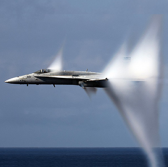 NASA and Honeywell have concluded a two-year test of a technology platform designed to help supersonic jet pilots reduce noise associated with sonic booms over populated areas.
NASA and Honeywell have concluded a two-year test of a technology platform designed to help supersonic jet pilots reduce noise associated with sonic booms over populated areas.
The test included the integration of the Interactive Sonic Boom Display Avionics software equipped with Honeywell’s Interactive Navigation tool into a business aircraft’s avionics system, the company said Wednesday.
“With predictive technology and knowledge, pilots can change course and minimize the boom over populated areas,” said Bob Witwer, vice president of advanced technology at Honeywell’s aerospace business.
Honeywell and the space agency demonstrated how the technology can help pilots assess and predict sonic booms during flights and protect populations from boom impact-related noise.
Brett Pauer, commercial supersonic technology subproject manager of overland supersonic flight at NASA, said the technology could be integrated with the agency’s experimental Low Boom Flight Demonstration aircraft.
“This plane is being designed to gather community noise response data that may help remove the regulatory speed restriction to overland commercial supersonic flight,†Pauer added.
Honeywell’s work is one of the eight research projects that NASA selected in 2015 to help address sonic booms and other challenges to commercial supersonic travel.




